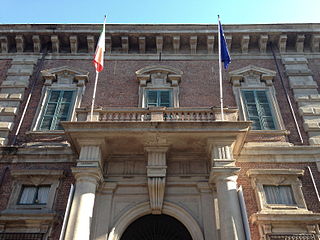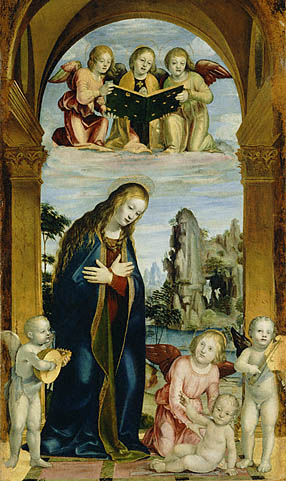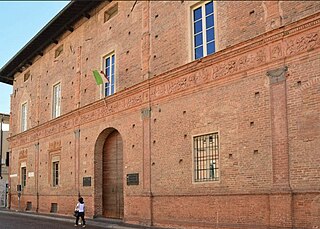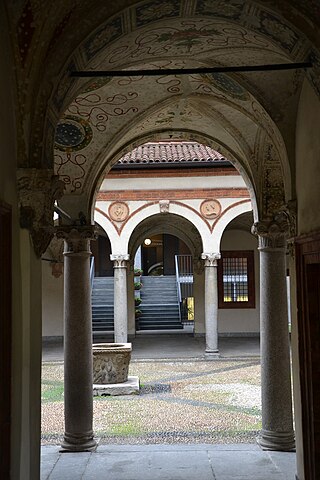History
The palace was the home of the Grifi family, also known as Griffi or Grifo, contractors for the collection of gabelle under the Sforza. The family, of merchant origins, had among its exponents influential intellectuals of the Sforza court. Particular mention should be made of Leonardo, archbishop of Benevento and author of poems, [1] and his brother Ambrogio, archiater at the court of Ludovico il Moro, to whom a chapel in San Pietro in Gessate is dedicated.
Construction of the palazzo was begun at the end of the 15th century [2] and completed in the following century, in post-Bramantesque forms. Among the building's many vicissitudes, in the 19th century it was the site of the Albergo Gran Parigi, terminus of the stagecoach (carriage) to Pavia. Despite this, it has preserved one of the best-preserved Renaissance-style courtyards in Milan.

Palazzo Brera or Palazzo di Brera is a monumental palace in Milan, in Lombardy in northern Italy. It was a Jesuit college for two hundred years. It now houses several cultural institutions including the Accademia di Brera, the art academy of the city, and its gallery, the Pinacoteca di Brera; the Orto Botanico di Brera, a botanical garden; an observatory, the Osservatorio Astronomico di Brera; the Istituto Lombardo Accademia di Scienze e Lettere, a learned society; and an important library, the Biblioteca di Brera.

The Certosa di Pavia is a monastery and complex in Lombardy, Northern Italy, situated near a small town of the same name in the Province of Pavia, 8 km (5.0 mi) north of Pavia. Built in 1396–1495, it was once located on the border of a large hunting park belonging to the Visconti family of Milan, of which today only scattered parts remain. It is one of the largest monasteries in Italy.

Benedetto Briosco (c.1460–c.1517) was an Italian Renaissance sculptor and architect, active in Lombardy.

BernardoZenale was an Italian painter and architect.

Bernardino de 'Conti was an Italian Renaissance painter, born in 1465 in Castelseprio and died around 1525.

The Sala delle Asse, is a large room in the Castello Sforzesco in Milan, the location of a painting in tempera on plaster by Leonardo da Vinci, dating from about 1498. Its walls and vaulted ceiling are decorated with "intertwining plants with fruits and monochromes of roots and rocks" and a canopy created by sixteen trees.

Santa Maria in Brera was a church in Milan, in Lombardy in northern Italy. It was built by the Humiliati between 1180 and 1229, given a marble façade and Gothic portal by Giovanni di Balduccio in the fourteenth century, and deconsecrated and partly demolished under Napoleonic rule in the early nineteenth century. The Napoleonic rooms of the Pinacoteca di Brera occupy the upper floor of what was the nave.

Cassina Baraggia is a hamlet of Brugherio's municipality, which until 1866 was a separate municipality.
The old farmhouses of Brugherio were agricultural structures typical of the Po-Valley in Lombardy, which gave its name to the surrounding areas as well, roughly corresponding to fractional towns in which Brugherio was divided. The union of the various small rural municipalities in which the territory was fragmented gave birth in 1866 to the municipality of Brugherio. Some are still visible: Bindellera, Casecca, Cattoni, Comolli, Dorderio, Guzzina, Increa, Modesta, Moia, Occhiate, Pareana, San Cristoforo, Sant'Ambrogio, San Paolo and Torazza.

The Arese are a prominent family of the Milanese nobility.

The Old Campus of the University of Pavia is a complex located in Pavia, in Lombardy, home to the rectorate and some university faculties and the University History Museum of the University of Pavia.

Palazzo Mezzabarba is a palace in Pavia, Lombardy, a notable example of Lombard rococo, It has been Pavia's city hall since 1875.

Palazzo Cornazzani is a palace in Pavia, in Lombardy, where, between 1895 and 1896, Albert Einstein lived.

Palace Carminali Bottigella is a noble palace built by the ancient Beccaria family from Pavia. The original structure from the Sforza era was built between 1490 and 1499. The façade, which retains the original terracotta decorations, is one of the major examples of Renaissance civil building in Pavia.

Palazzo Melzi di Cusano is a historic building situated in Via Monte Napoleone in Milan, Italy.

The Bicocca degli Arcimboldi is an aristocratic villa built in the second half of the 15th century as the country residence of the Famiglia degli Arcimboldi. Once situated in a totally rural area not far from Milan, it is now located within the homonymous district, in a now totally urbanised context.

Villa Simonetta is a villa Renaissance located in Milan at Via Stilicone 36, built at the end of the 15th century and then enlarged and renovated several times. Today, the villa is municipal property and is home to the Civica Scuola di Musica «Claudio Abbado».

Palazzo Carmagnola is a palazzo quattrocentesco in Milano, which was remodelled several times in the following centuries. Historically belonging to the Sestiere di Porta Comasina, it is located in via Rovello 2.

The Palazzo Dal Verme was the noble residence of one of the most powerful families of the Visconti and Sforza court in the 15th century. The courtyard remains today, one of the greatest examples of civil construction from the Renaissance era in Milan. It is located at 3 Via Giacomo Puccini.






















